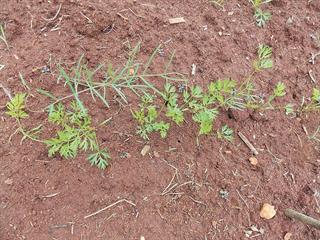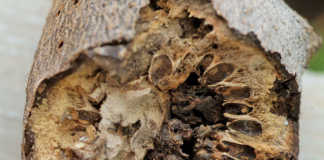
A weed is simply a plant growing in the wrong place. This means that a plant species cultivated intentionally on a farm can be considered a weed if it later emerges to compete with another planted crop.
I have had this happen on my land. Several years ago, I planted grazing vetch as a ground cover. In one section, I cut it down too late and it set seed. Today, it still comes up among my vegetables.
Preventing erosion and building up humus
Even inedible weeds not considered desirable in any way still serve a purpose. Weeds survive in conditions that would destroy most crops. Their ‘functions’ are to prevent erosion, provide organic matter to feed beneficial soil organisms and add humus to the soil.
Humus feeds a multitude of organisms. It also acts as a sponge to absorb moisture. It creates clusters (aggregates) of clay particles, which allow the soil to breathe and water to penetrate the soil more easily. Humus creates an environment that enables beneficial microbes, earthworms and other life to flourish because the fertility and physical properties of the soil are continually improved.
Weeds and pioneer species
Toxic, thorny and spiny plants are not usually grazed by animals, and are normally looked on with disapproval by farmers. Yet these are often the only plants that prevent soil deterioration and erosion in times of drought!
In nature, pioneer species can survive poor soil or adverse climatic conditions. These plants – weeds, if you prefer – are usually not particularly palatable to animals, which helps the plants survive. Because animals prefer more nutritious, palatable plants, the weeds slowly build up the soil so that the next group of higher-ranking plants can take over, followed by the group after that, until the highest-ranking plants suited to the climate and environment can flourish.
By the time the climax species take over the soil is much improved and far more vegetation is produced in a given area.
This is nature’s way and we can learn from it; it demonstrates importance of improving soil and the benefits that crops can derive from healthy soil. Under natural conditions, a climax species will not survive in pioneer conditions. Yet this is what we often expect when we plant a potentially productive crop in poor soil.
Fortunately, we can fast-track soil improvement by adding what is required. High-value crops such as vegetables make
it more affordable to speed up the process of improving the soil.
Indicator species
Some weed species prefer acidic soil and others alkaline soil. Some will survive in brackish soil and can stabilise and improve soil where other plants would not survive. Knowing which type of weeds thrive in a particular soil often tells us whether the soil is alkaline or acid, or rich or poor in a specific mineral.
These plants are referred to as indicator species. An example is Melilotus spp, which are often seen thriving alongside a tar road. This is because hydrated lime is added to the soil when a road is built, increasing the pH of the adjacent soil. If this weed is prevalent in an area, we can be certain that the soil pH is relatively high.
Bill Kerr is a vegetable specialist and a breeder of a range of vegetables.












